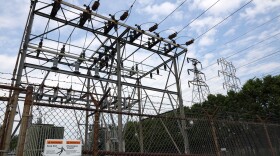Each year, ports on the Great Lakes dredge tons of material to keep shipping lanes open. But disposing of the spoils is a big problem. The Port of Toledo has a creative approach: farming.
The Port of Toledo dredges more sediment than any port on the Great Lakes – up to a million cubic yards every year. The idea of reusing sediment as soil for agriculture is new for the Great Lakes region and ideal for Lake Erie’s western basin.
“Because there are so many agricultural fields around this area in this watershed, it’s kind of a logical choice to take a look at returning this soil to where its ultimately coming from,” said Cappel.
Other cities have tried using dredged sediment for road improvements, construction and freeway bank restoration.
It doesn’t mean the soil solution is for every port, Cappel notes. Sediment in Toledo is made up of silt and clay. But 100 miles to the east, sediment from Cleveland’s Cuyahoga River is made up of sand and gravel.
Material dredged from the Maumee River is safe for planting crops and is not contaminated, Cappel says . The sediment can also be used to build up a field so it’s less prone to flooding.
Cappel says getting farmers to look at sediment as a useful material requires data and research they’ll conduct over the two-year project’s two-year period. But the project is anticipated to continue beyond 2017.
“The idea of this project is to change the perception of this material, get people more open to using it in their own projects because there’s plenty of it to go around,” said Cappel.
By the end of 2017, there will be about 100,000 cubic yards of sediment in four 2.5-acre cells along the Maumee River. The Great Lakes Dredged Material Center for Innovation also includes spots to create blended soil with other materials, like leaf compost. A tile system will drain water from the area into an edge of field system to reduce nutrient runoff.
In addition to using soil on agricultural fields, Toledo is testing another use for dredged sediment: wetlands.







